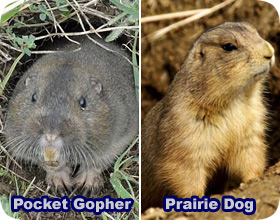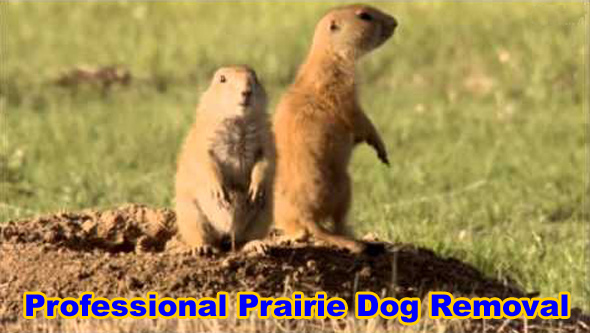-
info@aaanimalcontrol.com
Call us for help in your town
Humane Wildlife Education
How to Get Rid of Prairie Dogs
We are experts in prairie dog control methods, having performed thousands of prairie dog trapping and removal jobs nationwide.
 Prairie dogs are social animals and that is what can cause you problems if you live in an area where they live. Having one would be bad enough because they burrow, but having an infestation can spell disaster for your yard or garden.
The one thing that you should avoid is to fumigate where the prairie dogs burrow. The reason is because the fumigants are not only dangerous to the prairie dog; they are also dangerous to you and pets.
Trapping them is not as easy as it seems. The older ones are suspicious of new items in their habitat and will therefore stay away from traps. However, they can be trapped by experts.
Prairie dogs are social animals and that is what can cause you problems if you live in an area where they live. Having one would be bad enough because they burrow, but having an infestation can spell disaster for your yard or garden.
The one thing that you should avoid is to fumigate where the prairie dogs burrow. The reason is because the fumigants are not only dangerous to the prairie dog; they are also dangerous to you and pets.
Trapping them is not as easy as it seems. The older ones are suspicious of new items in their habitat and will therefore stay away from traps. However, they can be trapped by experts.
Need prairie dog removal in your hometown? We service over 500 USA locations! Click here to hire us in your town and check prices - updated for year 2020.

Preferred Habitats Of Prairie Dogs
Understanding the prairie dog means understanding its habitat. The habitat that the prairie dogs prefer depends on the species that you are talking about. There is a total of five different species in the United States alone. The five species are Gunnison prairie dog, Utah Prairie dog, and white-tailed, black tailed and Mexican prairie dog. They are all usually found in the grasslands in three different areas of prairie: tall grass, mixed-grass, and short grass. If you live in the western states then there is a good chance that you are in prairie dog country, but they are also found in Texas, Alabama, Oklahoma, North Dakota, South Dakota, Kansas and Nebraska.
Because they are not anywhere near major bodies of water they are not swimmers. They are extremely social animals so if you have seen one in your area, then you probably have plenty more. They will burrow underground leaving a crater at the entrance of the tunnel. This crater is usually tall. The reason for the tall crater is that when it rains the water will not flood the tunnels. They are smart animals and they will not like new things in the place where they live. That makes trapping them a bit trickier than it is with other animals.
Biology And Feeding Of Prairie Dogs
The term prairie dog is given to the animal not because it is related to the dog (it is a rodent) but because of their call which sounds a lot like that of dogs. They are big for a rodent growing to be as long as 16 inches and weigh about 3 pounds. They are usually found in high altitudes of 2,000 to 10,000 feet above the sea level. They are burrowing rodents and because of the areas they live in that burrow is what keeps them protected from the elements. Their burrows are usually long, reaching up to 33 feet in length.
Another thing to understand about prairie dogs is their diet. They are mostly an herbivorous species with the rare exception of insects. They live in the grasslands and that grass is the main item in their diet, though in the fall they also add broadleaf forbs to it. During the winter the females will eat snow as a source of water. They also eat fruits, seeds, roots, buds and cacti. The eating of grass and roots plus their burrowing habits are what makes the prairie dogs an undesired pest in your property, and the fact that they are hard to catch makes calling a wildlife expert a god solution.
Reproduction And Removal Of Prairie Dogs
The call of the prairie dog can mean two things. One is the approaching of a predator, and the second one is the mating call. The mating call can be recognized because as opposed to other calls it will be a repeated series of barks that can be as short as two or as long as 25. You will probably never see copulation of prairie dogs as it usually happens in the burrow. That is done to prevent predator attacks as well as the approaching of a competing male. Multiple-paternity in prairie dogs is a possibility, but it happens more often in the Gunnison and Utah species.
Because of the protection of the burrow, the prairie dog is very effective in reproducing. The fact that they are a social animal can also mean that you will have a lot of prairie dogs in your area in a few weeks. That makes getting rid of them a bit of a challenge. The younger prairie dogs are the easiest ones to catch as they are not suspicious of the traps yet. The older prairie dogs do take a lot more patience and that is why a lot of people choose to call exterminators.
How To Get Rid Of Prairie Dogs
Prairie dogs are not a canine. They are in fact closer to a squirrel that can be found in the grasslands of North America. They are social animals and that is what can cause you problems if you live in an area where they live. Having one would be bad enough because they burrow, but having an infestation can spell disaster for your yard or garden. The one thing that you should avoid is to fumigate where the prairie dogs burrow. The reason is because the fumigants are not only dangerous to the prairie dog; they are also dangerous to you and pets.
Trapping them is not as easy as it would be with other animals unless the prairie dogs are young. The older ones are suspicious of new items in their habitat and will therefore stay away from traps. Another thing to be concerned about is the rules and regulations in your area concerning the use of poisons to control prairie dogs. If you use a trap then you can try using grain as the bait as it seems to be some of the more effective ones.
SOME SPECIFIC PRAIRIE DOG AREAS OF INTEREST:
How To Get Rid Of Prairie Dogs In Your Shed?
A prairie dog infestation is not something that you will see a lot of in your shed, but it will happen from time to time. Prairie dogs are more likely to invade your yard or garden and can in fact burrow there, but you will find a few in the shed if the yard is not big enough for the number of prairie dogs and they have nowhere else to go. So if you find yourself in the unlucky position of finding these cute critters in your shed, then you have to know what to do.
The most humane way to get rid of prairie dogs is usually the use of traps, but they are not as effective. In the shed however it can actually work if the prairie dogs have no other way out. If they can find a way to get out of the shed then they will avoid the trap. Prairie dogs are extremely smart and will only approach traps when desperate for food. Poison is another one of those solutions that may or may not work. Keep in mind that house pets and small children could come in contact with the poison as well.
How To Get Rid Of Prairie Dogs In Your Garden
If you live in an area where prairie dogs live then there is a very good chance that at one point or another you will have prairie dogs in your garden. It is really hard to keep them out when they are determined to get to your garden and they will be because they will find food there. That means that you have to know what not to have in your garden if you ever hope to keep them out. A prairie dogs diet consists of grass, roots, fruits and vegetables, and that is because it is so hard to keep them out.
The first thing you will need to do is fence your garden, but because they are diggers you also need some underground fencing. Keeping them out is the best way to ensure that your problem does not get out of control. Trapping these rodents is not an easy task. Traps do not work all the time, but you are more likely to be able to trap the young prairie dogs. Using poisons has the same result except that even the young may not eat it.
Safely Remove Prairie Dogs From Your Yard
Having a nicely trimmed yard is something that home owners take a lot of pride in, but all that effort can go to waste the moment prairie dogs find your yard. Prairie dogs are right up there in the type of wildlife that is almost too adorable to want to take care of the problem. They are very closely related to squirrels but the damage they can do to your yard is much worse than almost any other pest. Your grass can become spotty and the burrowing can cause can be expensive to fix. So how do you get them out?
One of the most effective ways to get rid of prairie dogs in your yard is to flood the burrow. Keep in mind that there is a very good chance that some prairie dogs will drown so it is not the most humane way to get rid of them. The problem is that traps which are the humane way do not work very well against prairie dogs. Once you have flooded the burrows make sure that you plug it with dirt so that the ones that did not drown do not come back. You should also be careful not to over-flood the burrows.
Humanely Remove Prairie Dogs From A Field
The fact that you want to remove prairie dogs from a field in a humane manner speaks volumes of you as an animal lover. You should know however that getting them out of a field is not the easiest pest control that you will ever do. It is not easy at all to trap prairie dogs so you should get to work as soon as possible. Understand that traps are not that effective. At their best traps have a 50 percent success rate, but you should still use them while you try the next steps.
Because we are talking about a field it means that it is a larger area. The first thing to do is to look at the food supplies for the prairie dogs. Their diets include roots, fruits, vegetables, worms and of course grass. You should start with keeping the grass very low so that they do not have that. You should then remove the plants with roots that the prairie dogs will eat. Never feed the prairie dogs, they are smart and they will find a new food source. The insects and worms are something that you cannot do much about, but if they do not have the other food sources the bugs will not be enough and they will have no other choice but to move.








































